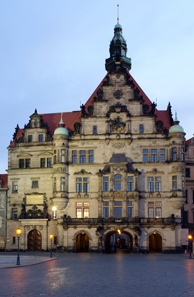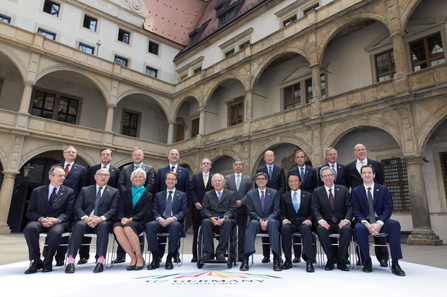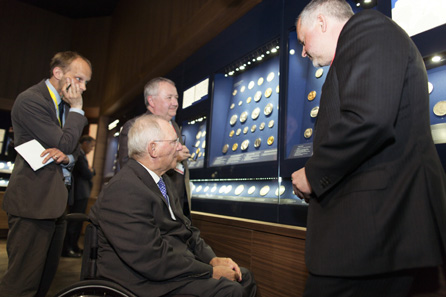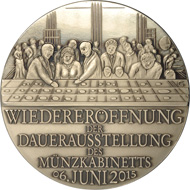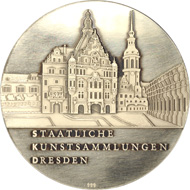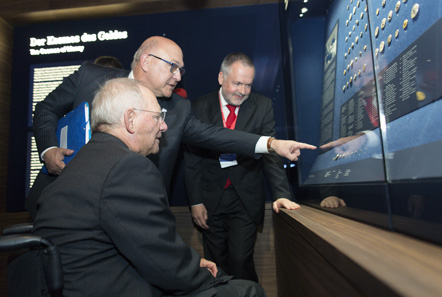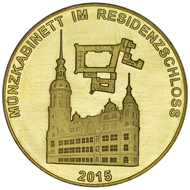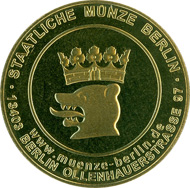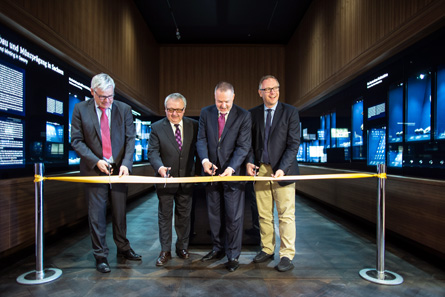by Björn Schöpe
translated by Annika Backe
June 18, 2015 – On June 6, 2015, the Dresden Coin Cabinet inaugurated its new permanent exhibition in the magnificent Georgenbau in the Royal Palace in Dresden. After decades of interim solutions, Germany’s third largest coin collection, comprising about 300,000 objects, had returned to its original location already in 2002. When we met Dr Rainer Grund, Director of the Coin Cabinet, it was clear to see that the following working on the new exhibition has taken its toll. Despite his busy schedule, he still found time to talk to us about the recent visit of the G7 Finance Ministers.
The Georgenbau. This is the collection’s original location to which it has now returned again. Photo: Kolossos / https://creativecommons.org/licenses/by-sa/3.0/deed.en
After 11 years with no permanent exhibition but, at least, some small-scale presentations to bridge the gap, the Dresden Coin Cabinet finally has its own exhibition area again (see an extensive article here). The reopening was met with considerable response from the national and international press, not least because of the visit of the finance ministers during the recent G7 Meeting. As Rainer Grund admits, this preview prior to the official opening was no coincidence…
‘Family portrait’ with participants of the G7 Meeting: the Finance Ministers socializing in the small courtyard of the Royal Palace. Photo: Thomas Köhler, Bundesministerium der Finanzen.
When, in autumn 2014, the State Art Collections Dresden learned about Wolfgang Schäuble’s plans to choose Dresden as venue for the G7 Finance Ministers Meeting from May 27 to 29, 2015, the General Directorate contacted the office of Mr Schäuble and offered an exclusive preview of the new exhibition. It was like pushing at an open door. For the Coin Cabinet, however, that meant that the exhibition’s opening scheduled for autumn had to be brought forward by a few months. It was virtually impossible but, thanks to more manpower and more money, the minor miracle happened…
In the interview, we could still see how relieved Rainer Grund is although not everything went according to plan. He gives quite a vivid account of how much organization it required to coordinate the work of all parties involved. The display cases have been manufactured and installed by the company Artex in Vienna, the architecture firm was based in Berlin and the graphic artists in Dresden… If there was a delay at one point, all further work stages were likewise on hold…
Royal Palace, venue of the G7 Finance Ministers Meeting. Photo: Kolossos / https://creativecommons.org/licenses/by-sa/3.0/deed.de
The G7 Meeting in itself was one of the retarding moments, responsible for a near-fatal blow to the immaculate schedule. After all, Dresden was under the highest level of security. The city center was divided into different zones with the Royal Palace, of course, demanding the highest safety measures as the meetings’ venue. The museum’s employees and third partners were given permits and could thus continue working on the exhibition, but those who were overlooked in the accreditation had to remain outside.
Admittedly, not every part of the exhibition was already finished when the ministers arrived but those parts that were already completed were quite impressive.
The cleaning crew was summoned rather urgently then, as Rainer Grund remarks with a chuckle. The goal was to neither violate any safety standards nor make the high-ranking guests walk through a filthy exhibition…
Prof Dr Hartwig Fischer, Director General of the State Art Collections Dresden, r., and Dr Rainer Grund, in the background l., are happy to welcome their prominent visitor, Finance Minister Schäuble. Photo: Thomas Köhler, Bundesministerium der Finanzen.
Then the time had come at last! On May 28, around 2:15 p.m., the Finance Ministers entered the, officially still closed, exhibition. Rainer Grund records that the halls were filled with dozens of people all of a sudden. There were not only the Finance Ministers, but their secretaries, assistants and every number of security personnel. Not to forget the press colleagues. The visit was not compulsory, and so it was a special honor for Dresden that the British Chancellor of the Exchequer, George Osborne, and his French colleague, Michel Sapin, showed up as well.
For the notable guests, the visit was worth wile at any rate, for Rainer Grund had selected the highlights for his presentation well in advance and prepared comments in English. This was also a good opportunity to check the exhibition’s accessibility. After all, it had to be made sure ‘that the German Minister would be able to see every single highlight from his wheelchair.’
The medal on the reopening of the Coin Cabinet was created by Peter-Götz Güttler. Copyright: Staatliche Kunstsammlungen Dresden.
The welcome speech held by Prof Dr Hartwig Fischer, Director General of the State Art Collections Dresden, was followed up by the presentation of gifts. The State Art Collections Dresden offered a lavish catalogue on the portrait medal in the German Renaissance as well as a cast medal which Peter-Götz Güttler had created in celebration of the museum’s reopening. In line with this, Finance Minister Schäuble presented his gift, the current 2 Euro commemorative coin set “25 Years German Unity”.
2600 years of monetary history, illustrated by selected highlights, were packed into 30 minutes. Photo: Thomas Köhler, Bundesministerium der Finanzen.
Then the tour started. Hartwig Fischer guided the group in English (with some parts of the conversation held in German sometimes), and Rainer Grund stepped in as expert when there was need for further clarification. Both had taken up the challenge of familiarizing their prominent guests with 2600 years of monetary history in just 30 minutes in the midst of an exhibition that comprised 3300 objects!
Mr Schäuble showed great interest in particular exhibits. Photo: Thomas Köhler, Bundesministerium der Finanzen.
Mr Schäuble was especially interested in both the oldest coin and the heaviest coin – he thus applied a clear mathematical standard.
French Finance Minister Sapin knew a thing or two about numismatics. Photo: Thomas Köhler, Bundesministerium der Finanzen.
When one of the oldest coins, minted by Alyattes around 600 BC, came into focus, his colleague Sapin demonstrated numismatic knowledge in that he instantly identified it correctly. For the most part, however, the visitors allowed themselves to be impressed. According to Rainer Grund, the atmosphere was ‘hectic and busy’ which shouldn’t come as a surprise considering the tight time frame. On the other hand, he was pleasantly surprised by the fact that the guests were ‘amazed to see the well-designed presentation of these gems’. For quite some time now, Hartwig Fischer propagates the new museum as the ‘new treasure chamber of Dresden’ (a term that should avoid any confusion with the Green Vault, Dresden’s treasure chamber proper).
The visitors were so fascinated that Hartwig Fischer exceeded the time allotted to him, until Mr Schäuble made him aware of the schedule again. A couple of minutes later, the numismatists had the coins to themselves again – as the not yet finished museum.
On the occasion of the reopening, the Staatliche Münze Berlin presented all staff members of the Coin Cabinet with a commemorative medal. Photo: Staatliche Münze Berlin.
There was no time to rest after this mega event though. So many things had to done before the inauguration. To be honest, everything was finished only just in time, as Rainer Grund admits: ‘The last objects were put into the display cases the night before the opening.’
During the inauguration, all Coin Cabinet staff members were given a surprise that made the director very happy: In celebration of the reopening of the Dresden Coin Cabinet, the Staatliche Münze Berlin had manufactured a commemorative medal.
Ribbon-cutting, on the occasion of the inauguration of the permanent exhibition of the Coin Cabinet on June 6, 2015. Photo: Oliver Killig. Copyright: Staatliche Kunstsammlungen Dresden.
The plans of the museum did work out: All media reported about the notable politicians visiting the new Coin Cabinet in Dresden. So much public attention for numismatics in general and Dresden in particular will surely bear fruit. Rainer Grund hopes for the exhibition ‘to be quite popular for a long period of time’.
CoinsWeekly can only agree with this. We congratulate on this PR coup of having given the finance ministers of the most important economic powers a tour around the Dresden Coin Cabinet. And we wish the new exhibition good luck and hundreds of thousands of visitors.
Read more about the reopening in this article.
To visit the website of the Coin Cabinet, please click here.
The medal created by Peter-Götz Güttler, either made of fine silver or kaiserzinn, is available for sale in the museum shop of the Royal Palace, Walther König bookstore.




